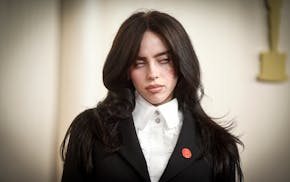Julian Schnabel's movie about Vincent van Gogh, "At Eternity's Gate," gives us long, enormous close-ups of Willem Dafoe's wonder-filled eyes. It's a brilliant strategy because it makes us want to see what the painter is seeing.
Like all movies about van Gogh, including last year's "Loving Vincent," 1956's "Lust for Life" and Robert Altman's 1990 "Vincent and Theo," this one zeros in on the fact that the Dutchman is now universally acknowledged as one of the greatest artists of all time but, while he was alive, couldn't get a gig painting a fence. A painter himself, Schnabel hits that point often — maybe too often? — in scenes such as one in which a bar owner rips down a wall of van Gogh paintings, many of them among the most famous artworks in the world today.
What distinguishes "Gate" from its predecessors are its intimacy and intensity. In addition to Dafoe, Rupert Friend as loving brother Theo and Oscar Isaac as painter Paul Gaugin are showcased in straight-up-the-nostril close-ups, as if cinematographer Benoit Delhomme is trying to peer into their brains.
Likewise, Tatiana Lisovkaia's score follows the trend of in-your-face music that functions almost like a character (see also Jonny Greenwood's "The Phantom Thread" and Mica Levi's "Jackie"). Mostly, it's rhythmic, piano-heavy music with a melody that recalls Simon and Garfunkel's "Old Friends," but one remarkable scene makes a shift: Van Gogh stares at a tree, sketching it with tiny crosshatches. Suddenly, a violin takes up the melody, the switch to the more ethereal instrument making it feel like the movie is shifting from inside van Gogh's head into his soaring heart.
The spare screenplay juxtaposes koan-like insights into van Gogh's process ("What do you paint?" he is asked, to which he replies, "Sunlight"), with images that recall Terrence Malick movies — by which I mean that there are many scenes of van Gogh walking through rustling reeds at twilight.
Moviegoers may be surprised how often we see van Gogh in joyful times. He's generally understood as someone who suffered from undiagnosable-at-the-time mental illnesses — and yes, there's a scene where he's given a "treatment" that's essentially waterboarding — but Schnabel insists that the artist was mostly powerful and confident when he was at work. "When I paint," van Gogh says, "I stop thinking and I feel I am part of everything."
Schnabel also excels at capturing the relationship between Vincent and Theo, highlighted by a quiet, tender moment when Vincent is confined to an asylum and Theo, having traveled more than a day to visit, climbs into bed with his brother for a whispered conversation about their shared childhood. Dafoe, simultaneously conveying pain and affection, and Friend, aching with compassion, create an exquisite portrait of brotherly devotion.
"At Eternity's Gate" is studded with places and people that will delight anyone familiar with van Gogh's work. A letter carrier delivers a package and you realize he's depicted in the famed "Portrait of the Postman Joseph Roulin." The painter moves into new digs and you recognize the "Bedroom at Arles" that now hangs in Paris' Musee d'Orsay.
The contrast between our familiarity with these works and the movie characters' disinterest in them creates a sense of the painter planting seeds of trees that he won't live to see, but that we've been enjoying for more than a century.
That long-game approach is reflected in the bold casting of Dafoe, who's 26 years older than van Gogh lived to be. The choice pays off because Dafoe's elegiac quality hints at why the artist was ahead of his time: because he saw more than anyone else could. It's a towering performance in a movie that casts a magnetic spell.
Chris Hewitt • 612-673-4367 • @HewittStrib
Jerry Seinfeld's commitment to the bit
Surging auto insurance rates squeeze drivers, fuel inflation
